A Comparative Study of Sustainable Transition from Catch-up to Post Catch-up of South Korea and China
Abstract
1. Introduction
2. Theoretical Background
2.1. Global Value Chain and Innovation System
2.2. Literature Reviews of the Catch-up and Post Catch-up Frameworks
3. Methodology and Research Design
- An ANOVA test was conducted for each country’s TCT (scale: year) in terms of time groups to examine whether the increasing pattern of TCT for Korea and V-shaped pattern for China were present or not. This is comparison within a country.
- (Time group 1: 1998–2002, time group 2: 2003–2007, time group 3: 2008–2012).
- A Pairwise T test was used for comparing the mean differences of Korea, China, Japan, and the US’s TCT over 15 years. The pairwise t-test was performed to see whether the TCT of Korea and China show a converging pattern or not. This is country-to-country comparison.
- An ANOVA test was conducted on each country’s localization of knowledge creation (scale: percentage) in terms of time groups to examine whether the localization of knowledge creation for both Korea and China shows increasing patterns in terms of time groups. This is comparison within a country.
- A Pairwise t test was used for comparing the mean differences of Korea, China, Japan, and the US’s localization of knowledge creation over 15 years. A pairwise t-test was performed to see whether the localization of knowledge creation of Korea and China shows converging pattern or not. This is country-to-country comparison.
- An ANOVA test was conducted on each country’s basic research expenditure and gross domestic expenditure on basic research as percentage in terms of time groups to examine whether the basic research expenditure (scale: purchasing power parity by dollars, in thousands) and GDEB (scale: percentage) for both countries show increasing patterns in terms of time groups. This is comparison within a country.
- A pairwise t-test was used for comparing the mean differences of Korea, China, Japan, and the US’s GDEB over 15 years. A pairwise t-test was performed to see whether the GDEB of Korea and China show a converging pattern or not. This is country-to-country comparison. This study did not conduct a pairwise t-test for basic research expenditure. This was because the absolute amount of the basic research expenditure will strongly depends on a country’s size (especially GDP and population) and country-to-country comparisons may not be suitable.
4. Statistical Analysis of the Research
4.1. Statistical Analysis of Technology Cylce Time
- Can we really distinguish technology fields or industries with long TCT and short TCT in the first place?
- Do TCTs from technology fields show converging or diverging patterns?
4.2. Statistical Analysis of Self-Citation Ratio at Country Level
4.3. Statistical Analysis of Basic Research Expenditure and GDEB at Country Level
5. Discussion of the Research
- A study that discovers the dynamic natures between the three dimensions of the research and other social factors
- A study that links sectoral innovation system dynamics with national landscape’s change during catch-up to post catch-up transition
- A study that illuminates the conflict and politics involved in the process of transition from catch-up to post catch-up transition
6. Conclusions
Author Contributions
Funding
Conflicts of Interest
Appendix A
| A. Elements of the Washington Consensus | South Korea | Taiwan | China |
|---|---|---|---|
| Macroeconomic Stabilities | |||
| 1. Fiscal Discipline | Yes, generally | Yes | Yes, generally |
| 2. Redirections of publish expenditure to health, education, infrastructure | Yes | Yes | Yes, generally |
| 3. Tax reform, broadening the tax base | Yes | Yes | Yes, since 1994 |
| 4. Unified & competitive exchange rates | Yes | Yes | Yes, since 1994 |
| 5. Secure property rights | Yes | Yes, Generally | Mixed |
| Privatization, Deregulation, Liberalization | |||
| 6. Deregulation | Limited | Limited | Limited |
| 7. Trade liberalization | Limited until 80s | Limited until 80s | Limited till 2002 |
| 8. Privatization | No from 50s~60s | No from 50s~60s | Partly no |
| 9. Elimination of barriers to FDI | Heavily restricted | State control | Regulated |
| 10. Financial liberalization | Limited till 90s | Limited till 80s | Limited till 80s |
| B. Elements Missing from the WC | |||
| 11. Export promotion & Import Tariffs | Yes, very strong | Yes | Yes, very strong |
| 12. Technology policy for upgrading (Public, in house R&D, joint ventures) | Yes, since 70s | Yes, since 80s | Given priority since mid-90s |
| 13. Higher education revolution (Doubling of number of college students) | Yes, since 1980s | Yes, generally | Yes, since 90s |
Appendix B
| 1998–2002 | 2003–2007 | 2008–2012 | |||||||||
|---|---|---|---|---|---|---|---|---|---|---|---|
| IPC | TCT | N | Percent | IPC | TCT | N | Percent | IPC | TCT | N | Percent |
| H01L | 6.37 | 2627 | 17.58% | H01L | 7.08 | 2931 | 15.69% | H01L | 9.33 | 3668 | 15.21% |
| G11C | 5.74 | 1151 | 7.70% | G02F | 7.62 | 1547 | 8.28% | G11C | 8.26 | 1730 | 7.17% |
| H04N | 6.89 | 935 | 6.26% | G11C | 6.76 | 1320 | 7.07% | G06F | 10.48 | 1568 | 6.50% |
| G11B | 7.51 | 866 | 5.80% | G06F | 8.23 | 940 | 5.03% | G02F | 10.05 | 1395 | 5.78% |
| G06F | 7.01 | 832 | 5.57% | H04B | 7.92 | 848 | 4.54% | H04B | 9.72 | 1231 | 5.03% |
| G02F | 6.35 | 595 | 3.98% | G11B | 8.51 | 830 | 4.44% | G09G | 10.16 | 931 | 3.86% |
| H04B | 6.43 | 353 | 2.36% | H04N | 8.62 | 607 | 3.25% | H04N | 11.02 | 839 | 3.48% |
| H01J | 8.62 | 338 | 2.26% | G02B | 7.92 | 538 | 2.88% | H04L | 9.84 | 772 | 3.20% |
| G02B | 7.29 | 316 | 2.11% | H01J | 8.48 | 421 | 2.25% | G11B | 10.27 | 618 | 2.56% |
| B41J | 8.13 | 264 | 1.77% | H04L | 7.71 | 391 | 2.09% | H04W | 9.96 | 576 | 2.39% |
| Total | 7.54 | 14942 | 100% | Total | 8.38 | 18678 | 100% | Total | 10.30 | 24118 | 100% |
| 1998–2002 | 2003–2007 | 2008–2012 | |||||||||
|---|---|---|---|---|---|---|---|---|---|---|---|
| IPC | TCT | N | Percent | IPC | TCT | N | Percent | IPC | TCT | N | Percent |
| B01J | 13.26 | 38 | 12.30% | H05K | 6.82 | 90 | 8.00% | H05K | 8.08 | 523 | 11.46% |
| H01L | 7.00 | 21 | 6.80% | G06F | 7.88 | 58 | 5.16% | G06F | 9.75 | 446 | 9.77% |
| A61K | 8.71 | 14 | 4.53% | H01L | 7.24 | 58 | 5.16% | H01L | 10.06 | 206 | 4.51% |
| B01D | 12.30 | 10 | 3.24% | G11B | 7.98 | 54 | 4.80% | H01R | 9.30 | 184 | 4.03% |
| C08F | 12.70 | 10 | 3.24% | B01J | 13.63 | 41 | 3.64% | H04L | 9.99 | 177 | 3.88% |
| A47J | 13.63 | 8 | 2.59% | H01R | 9.39 | 31 | 2.76% | F21V | 7.60 | 159 | 3.48% |
| C07D | 11.50 | 8 | 2.59% | H04B | 8.67 | 30 | 2.67% | G11B | 9.42 | 118 | 2.59% |
| G06F | 8.13 | 8 | 2.59% | A61K | 11.52 | 29 | 2.58% | H04B | 10.28 | 106 | 2.32% |
| G11C | 6.86 | 7 | 2.27% | G02B | 8.73 | 26 | 2.31% | H04W | 10.14 | 97 | 2.13% |
| A01N | 10.60 | 5 | 1.62% | G01N | 10.90 | 20 | 1.78% | H04J | 10.05 | 83 | 1.82% |
| Total | 10.50 | 309 | 100% | Total | 9.749 | 1125 | 100% | Total | 10.53 | 4563 | 100% |
Appendix C
| IPC | Description From WIPO | |
|---|---|---|
| Class | Subclass | |
| A | HUMAN NECESSITIES | |
| A01N | PRESERVATION OF BODIES OF HUMANS OR ANIMALS OR PLANTS OR PARTS THEREO; BIOCIDES; PEST REPELLANTS OR ATTRACTANTS; PLANT GROWTH REGULATORS | |
| A47J | KITCHEN EQUIPMENT; COFFEE MILLS; SPICE MILLS; APPARATUS FOR MAKING BEVERAGES | |
| A61K | PREPARATIONS FOR MEDICAL, DENTAL, OR TOILET PURPOSES | |
| B | PERFORMING OPERATIONS; TRANSPORTING | |
| B01D | SEPARATION. This subclass covers evaporation, distillation, crystallisation, filtration, dust precipitation, gas cleaning, absorption, adsorption; | |
| B01J | CHEMICAL OR PHYSICAL PROCESSES, e.g., CATALYSIS, COLLOID CHEMISTRY; THEIR RELEVANT APPARATUS | |
| B41J | TYPEWRITERS; SELECTIVE PRINTING MECHANISMS, i.e., MECHANISMS PRINTING OTHERWISE THAN FROM A FORME; CORRECTION OF TYPOGRAPHICAL ERRORS | |
| C | CHEMISTRY; METALLURGY | |
| C07D | HETEROCYCLIC COMPOUNDS | |
| C08F | MACROMOLECULAR COMPOUNDS OBTAINED BY REACTIONS ONLY INVOLVING CARBON-TO-CARBON UNSATURATED BONDS | |
| F | MECHANICAL ENGINEERING; LIGHTING; HEATING; WEAPONS; BLASTING | |
| F21V | FUNCTIONAL FEATURES OR DETAILS OF LIGHTING DEVICES OR SYSTEMS THEREOF; STRUCTURAL COMBINATIONS OF LIGHTING DEVICES WITH OTHER ARTICLES, NOT OTHERWISE PROVIDED FOR | |
| G | PHYSICS | |
| G01N | INVESTIGATING OR ANALYSING MATERIALS BY DETERMINING THEIR CHEMICAL OR PHYSICAL PROPERTIES | |
| G02B | OPTICAL ELEMENTS, SYSTEMS, OR APPARATUS | |
| G02F | DEVICES OR ARRANGEMENTS, THE OPTICAL OPERATION OF WHICH IS MODIFIED BY CHANGING THE OPTICAL PROPERTIES OF THE MEDIUM OF THE DEVICES OR ARRANGEMENTS FOR THE CONTROL OF THE INTENSITY, COLOUR, PHASE, POLARISATION OR DIRECTION OF LIGHT, | |
| G06F | ELECTRIC DIGITAL DATA PROCESSING (computer systems based on specific computational models G06N) | |
| G09G | ARRANGEMENTS OR CIRCUITS FOR CONTROL OF INDICATING DEVICES USING STATIC MEANS TO PRESENT VARIABLE INFORMATION. | |
| G11B | INFORMATION STORAGE BASED ON RELATIVE MOVEMENT BETWEEN RECORD CARRIER AND TRANSDUCER | |
| G11C | STATIC STORES (information storage based on relative movement between record carrier and transducer G11B; semiconductor devices for storage H01L) | |
| H | ELECTRICITY | |
| H01J | ELECTRIC DISCHARGE TUBES OR DISCHARGE LAMPS. | |
| H01L | SEMICONDUCTOR DEVICES; ELECTRIC SOLID STATE DEVICES NOT OTHERWISE PROVIDED FOR | |
| H01R | LECTRICALLY-CONDUCTIVE CONNECTIONS; STRUCTURAL ASSOCIATIONS OF A PLURALITY OF MUTUALLY-INSULATED ELECTRICAL CONNECTING ELEMENTS; COUPLING DEVICES; CURRENT COLLECTORS | |
| H04B | ELECTRIC COMMUNICATION TECHNIQUE. | |
| H04J | MULTIPLEX COMMUNICATION (peculiar to transmission of digital information H04L 5/00; systems for the simultaneous or sequential transmission of more than one television signal H04N 7/08; in exchanges H04Q 11/00) | |
| H04L | TRANSMISSION OF DIGITAL INFORMATION, e.g., TELEGRAPHIC COMMUNICATION. | |
| H04N | PICTORIAL COMMUNICATION, e.g., TELEVISION | |
| H04W | WIRELESS COMMUNICATION NETWORKS | |
| H05K | PRINTED CIRCUITS; CASINGS OR CONSTRUCTIONAL DETAILS OF ELECTRIC APPARATUS; MANUFACTURE OF ASSEMBLAGES OF ELECTRICAL COMPONENTS | |
Appendix D
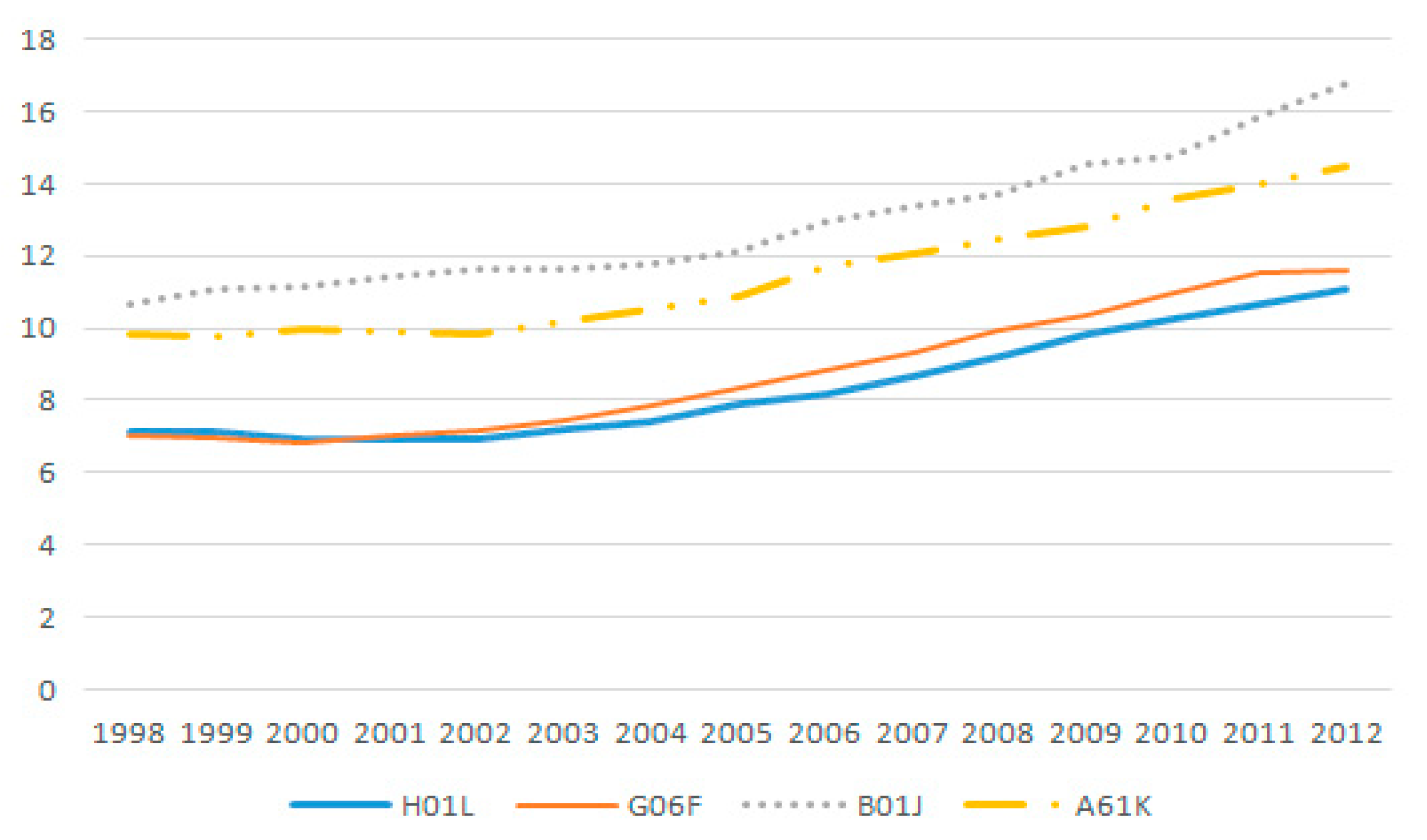
Appendix E
| Basic Research Expenditure (Thousands, PPP by $) | Gross Domestic Expenditure on Basic Research as % | ||||||||
|---|---|---|---|---|---|---|---|---|---|
| Year | Korea | China | Japan | US | Year | Korea | China | Japan | US |
| 1998 | 2,043,966 | 1,037,586 | 10,949,658 | 35,334,000 | 1998 | 0.30% | 0.03% | 0.35% | 0.39% |
| 1999 | 2,153,255 | 1,249,438 | 11,365,388 | 38,876,000 | 1999 | 0.28% | 0.04% | 0.35% | 0.40% |
| 2000 | 2,336,813 | 1,725,994 | 12,244,789 | 42,752,000 | 2000 | 0.27% | 0.05% | 0.36% | 0.42% |
| 2001 | 2,674,174 | 2,058,269 | 12,647,915 | 47,727,000 | 2001 | 0.29% | 0.05% | 0.36% | 0.45% |
| 2002 | 3,083,037 | 2,757,281 | 13,678,365 | 51,902,000 | 2002 | 0.31% | 0.06% | 0.38% | 0.47% |
| 2003 | 3,482,398 | 3,255,597 | 14,176,580 | 56,089,000 | 2003 | 0.34% | 0.06% | 0.38% | 0.49% |
| 2004 | 4,281,532 | 4,180,854 | 14,073,181 | 57,731000 | 2004 | 0.39% | 0.07% | 0.36% | 0.47% |
| 2005 | 4,698,624 | 4,650,566 | 15,443,210 | 61,321,000 | 2005 | 0.40% | 0.07% | 0.38% | 0.47% |
| 2006 | 5,365,597 | 5,475,108 | 16,151,773 | 62,996,000 | 2006 | 0.43% | 0.07% | 0.38% | 0.46% |
| 2007 | 6,386,200 | 5,841,934 | 17,035,880 | 68,047,000 | 2007 | 0.47% | 0.06% | 0.39% | 0.47% |
| 2008 | 7,047,174 | 6,989,765 | 16,93,207 | 72,105,000 | 2008 | 0.50% | 0.07% | 0.38% | 0.49% |
| 2009 | 8,304,338 | 8,632,067 | 17,113,343 | 73,772,000 | 2009 | 0.59% | 0.08% | 0.40% | 0.51% |
| 2010 | 9,506,676 | 9,808,655 | 17,057,047 | 75,070,000 | 2010 | 0.63% | 0.08% | 0.38% | 0.50% |
| 2011 | 1,0546,878 | 11,747,542 | 18,192,481 | 74,752,000 | 2011 | 0.68% | 0.08% | 0.40% | 0.48% |
| 2012 | 11,876,784 | 14,152,619 | 18,978,063 | 73,284,000 | 2012 | 0.74% | 0.09% | 0.40% | 0.45% |
References
- Lee, K.; Im, B.; Han, J. The National innovation system (NIS) for the catch-up and post-catch-up stages in South Korea. In The Korean Government and Public Policies in a Development Nexus; Springer: Cham, Switzerland, 2017; pp. 69–82. [Google Scholar]
- Gereffi, G. Global value chains in a post-Washington Consensus world. Rev. Int. Political Econ. 2014, 21, 9–37. [Google Scholar] [CrossRef]
- Gereffi, G.; Humphrey, J.; Sturgeon, T. The governance of global value chains. Rev. Int. Political Econ. 2005, 12, 78–104. [Google Scholar] [CrossRef]
- Humphrey, J.; Schmitz, H. How does insertion in global value chains affect upgrading in industrial clusters? Reg. Stud. 2002, 36, 1017–1027. [Google Scholar] [CrossRef]
- Giuliani, E.; Pietrobelli, C.; Rabellotti, R. Upgrading in global value chains: Lessons from Latin American clusters. World Dev. 2005, 33, 549–573. [Google Scholar] [CrossRef]
- Lundvall, B.A. The Learning Economy and the Economics of Hope; Anthem Press: London, UK, 2016; pp. 351–373. [Google Scholar]
- Nelson, R.R. National Innovation Systems: A comparative Analysis; Oxford University Press: New York, NY, USA, 1993. [Google Scholar]
- Lee, K.; Szapiro, M.; Mao, Z. From global value chains (GVC) to innovation systems for local value chains and knowledge creation. Eur. J. Dev. Res. 2018, 30, 424–441. [Google Scholar] [CrossRef]
- Park, J.; Lee, D.; Lee, K. The Determinants of foreign direct investment in R&D: Different inducement effects of private and public R&D in developed and developing host countries. Singap. Econ. Rev. 2020, 1–29. Available online: https://doi.org/10.1142/S0217590819500759 (accessed on 6 June 2020).
- Lee, K.; Wong, C.Y.; Intarakumnerd, P.; Limapornvanich, C. Is the fourth industrial revolution a window of opportunity for upgrading or reinforcing the middle-income trap? Asian model of development in Southeast Asia. J. Econ. Policy Reform 2019, 1–18. Available online: https://doi.org/10.1080/17487870.2019.1565411 (accessed on 6 June 2020). [CrossRef]
- Lee, K.; Lee, J. The National Innovation System (NIS) and readiness for the fourth industrial revolution: South Korea compared with four European countries. In Transforming Industrial Policy for the Digital Age; Edward Elgar Publishing: Cheltenham, UK, 2019; pp. 68–81. [Google Scholar]
- Fu, X.; Pietrobelli, C.; Soete, L. The role of foreign technology and indigenous innovation in the emerging economies: Technological change and catching-up. World Dev. 2011, 39, 1204–1212. [Google Scholar] [CrossRef]
- Fagerberg, J. Technology and international differences in growth rates. J. Econ. Lit. 1994, 32, 1147–1175. [Google Scholar]
- Fagerberg, J. The Changing Global Economic Landscape: The factors that Matter. In The Shape of the Division of Labour: Nations, Industries and Households; Edward Elgar Publishing: Cheltenham, UK, 2010; pp. 6–31. [Google Scholar]
- Lee, K.; Jee, M.; Eun, J.H. Assessing China’s economic catch-up at the firm level and beyond: Washington Consensus, East Asian Consensus and the Beijing model. Ind. Innov. 2011, 18, 487–507. [Google Scholar] [CrossRef]
- Park, J.; Ryu, D.; Lee, K. What determines the economic size of a nation in the world: Determinants of a nation’s share in world GDP vs. per capita GDP. Struct. Chang. Econ. Dyn. 2019, 51, 203–214. [Google Scholar] [CrossRef]
- Rodrik, D. Understanding economic policy reform. J. Econ. Lit. 1996, 34, 9–41. [Google Scholar]
- Lee, K. The Washington Consensus and East Asian sequencing: Understanding reform in East and South Asia. In Understanding Market Reform; Palgrave Macmillan: London, UK, 2006; pp. 99–140. [Google Scholar]
- Gerschenkron, A. Economic Backwardness in Historical Perspective: A Book of Essays; Belknap Press of Harvard University Press: Cambridge, MA, USA, 1962. [Google Scholar]
- Fagerberg, J.; Manual, G. Innovation and Catch-up. In The Oxford Handbook of Innovation; Oxford University Press: London, UK; New York, NY, USA, 2005. [Google Scholar]
- Song, W.; Seong, J.; Kim, Y.; Hwang, H.; Choung, J. In search of post catch-up innovation system. STEPI Policy Res. 2006, 25, 1–530. [Google Scholar]
- Kindleberger, C.P. World Economic Primacy: 1500-1900; Oxford University Press: New York, NY, USA, 1996. [Google Scholar]
- Amsden, A.H. The Rise of “the Rest”: Challenges to the West from Late-Industrializing Economies; Oxford University Press: New York, NY, USA, 2001. [Google Scholar]
- Lee, K. Schumpeterian Analysis of Economic Catch-Up: Knowledge, Path-Creation, and the Middle-Income Trap; Cambridge University Press: Cambridge, UK, 2013. [Google Scholar]
- Lee, K. The Art of Economic Catch-Up: Barriers, Detours and Leapfrogging in Innovation Systems; Cambridge University Press: Cambridge, UK, 2019. [Google Scholar]
- Utterback, J.M.; Abernathy, W. A dynamic model of process and product innovation. Omega 1975, 3, 639–656. [Google Scholar] [CrossRef]
- Bolton, M.K. Imitation versus innovation: Lessons to be learned from the Japanese. Organ. Dyn. 1993, 21, 30–45. [Google Scholar] [CrossRef]
- Kim, L. Imitation to Innovation: The Dynamics of Korea’s Technological Learning; Harvard Business School Press: Boston, MA, USA, 1997. [Google Scholar]
- Lee, J.; Bae, Z.T.; Choi, D.K. Technology development processes: A model for a developing country with a global perspective. RD Manag. 1988, 18, 235–250. [Google Scholar] [CrossRef]
- Lee, K.; Lim, C. Technological regimes, catching-up and leapfrogging: Findings from the Korean industries. Res. Policy 2001, 30, 459–483. [Google Scholar] [CrossRef]
- Park, K.; Ali, M.; Chevalier, F. A spiral process model of technological innovation in a developing country: The case of Samsung. Afr. J. Bus. Manag. 2011, 5, 5162–5178. [Google Scholar]
- Perez, C.; Soete, L. Catching Up in Technology: Entry Barriers and Windows of Opportunity in Technical Change and Economic Theory; Pinter Publishers: New York, NY, USA, 1998. [Google Scholar]
- Chang, S.; Kim, H.; Song, J.; Lee, K. Technological Opportunity, Technological Leadership Change, and Latecomers’ R&D Resource Allocation Between Innovation and Imitation. Technological Leadership Change, and Latecomers’ R&D Resource Allocation between Innovation and Imitation. (14 February 2020). Available online: https://ssrn.com/abstract=3538041 (accessed on 6 June 2020).
- Lee, K. Economics of technological leapfrogging. In Research and Statistics Working Paper; Department of Policy, UNIDO: Vienna, Austria, 2019; Volume 17. [Google Scholar]
- Lee, K.; Lee, J. National innovation systems, economic complexity, and economic growth: Country panel analysis using the US patent data. J. Evol. Econ. 2019, 29, 1–32. [Google Scholar] [CrossRef]
- Hwang, H. Beyond selection and concentration, through diversity and horizontal cooperation. Future Horizon 2014, 22, 36–39. [Google Scholar]
- Shin, H.; Lee, K. Impact of Financialization and financial development on inequality: Panel cointegration results using OECD data. Asian Econ. Pap. 2019, 18, 69–90. [Google Scholar] [CrossRef]
- Lim, J.; Lee, K. Employment effect of innovation under different market structures: Findings from Korean manufacturing firms. Technol. Forecast. Soc. Chang. 2019, 146, 606–615. [Google Scholar] [CrossRef]
- Henderson, R.; Clark, K. Architectural innovation: The reconfiguration of existing product technologies and the failure of established firms. Adm. Sci. Q. 1990, 35, 9–30. [Google Scholar] [CrossRef]
- Kang, R.; Jung, T.; Lee, K. Intellectual property rights and Korean economic development: The roles of patents, utility models and trademarks. Area Dev. Policy 2019, 5, 1–23. [Google Scholar] [CrossRef]
- Jaffe, A.B.; Trajtenberg, M.; Henderson, R. Geographic localization of knowledge spillovers as evidenced by patent citations. Q. J. Econ. 1993, 108, 577–598. [Google Scholar] [CrossRef]
- Narin, F.; Albert, M.B.; Smith, V.M. Technology indicators in strategic planning. Sci. Public Policy 1992, 19, 369–381. [Google Scholar]
- Hu, A. The regionalization of knowledge flows in East Asia: Evidence from patent citations data. World Dev. 2009, 37, 1465–1477. [Google Scholar] [CrossRef]
- OECD. Frascati Manual 2015: Guidelines for Collecting and Reporting Data on Research and Experimental Development, The Measurement of Scientific, Technological and Innovation Activities; OECD Publishing: Paris, France, 2015; Available online: https://www.oecd.org/sti/frascati-manual-2015-9789264239012-en.htm (accessed on 6 June 2020).
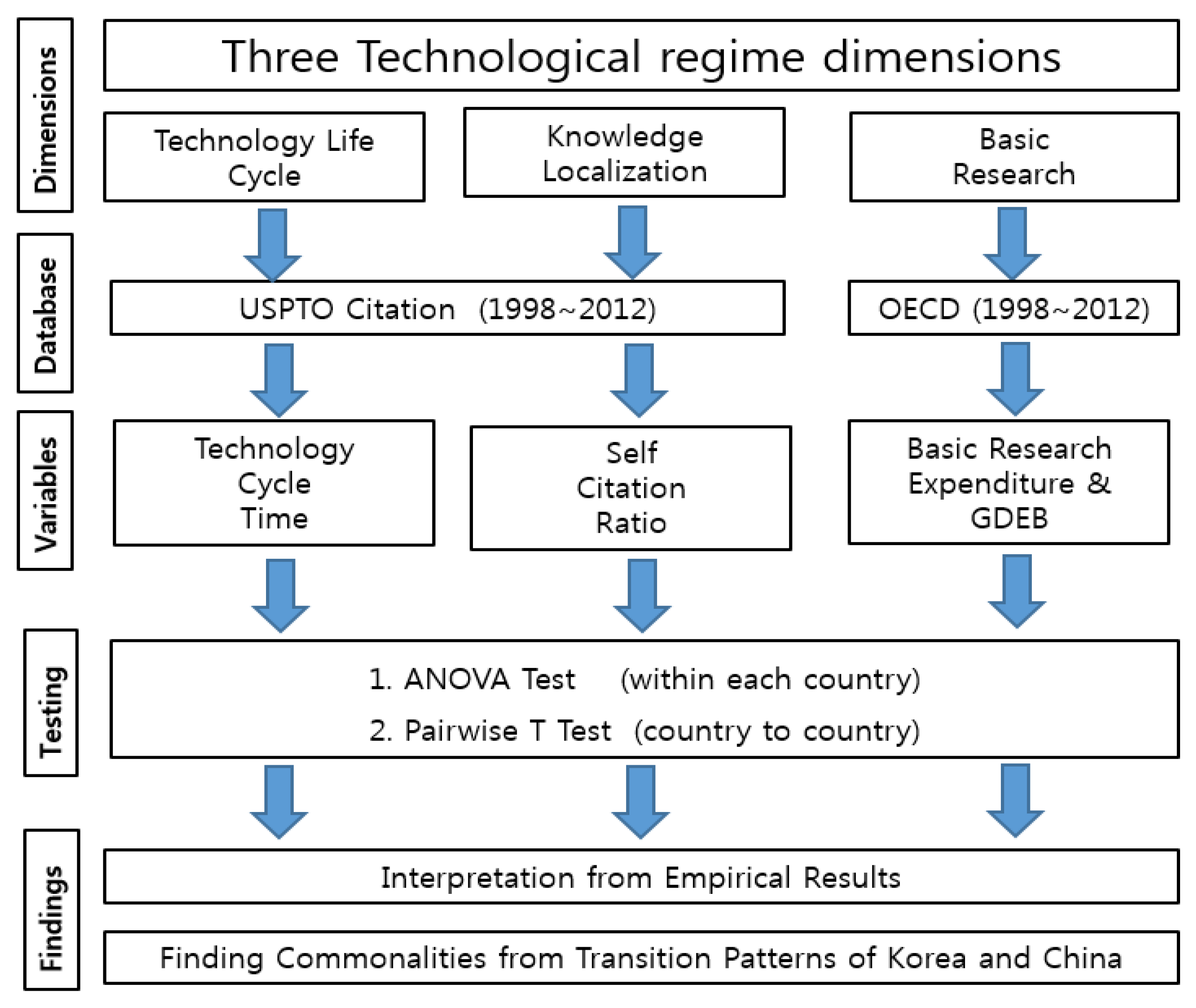
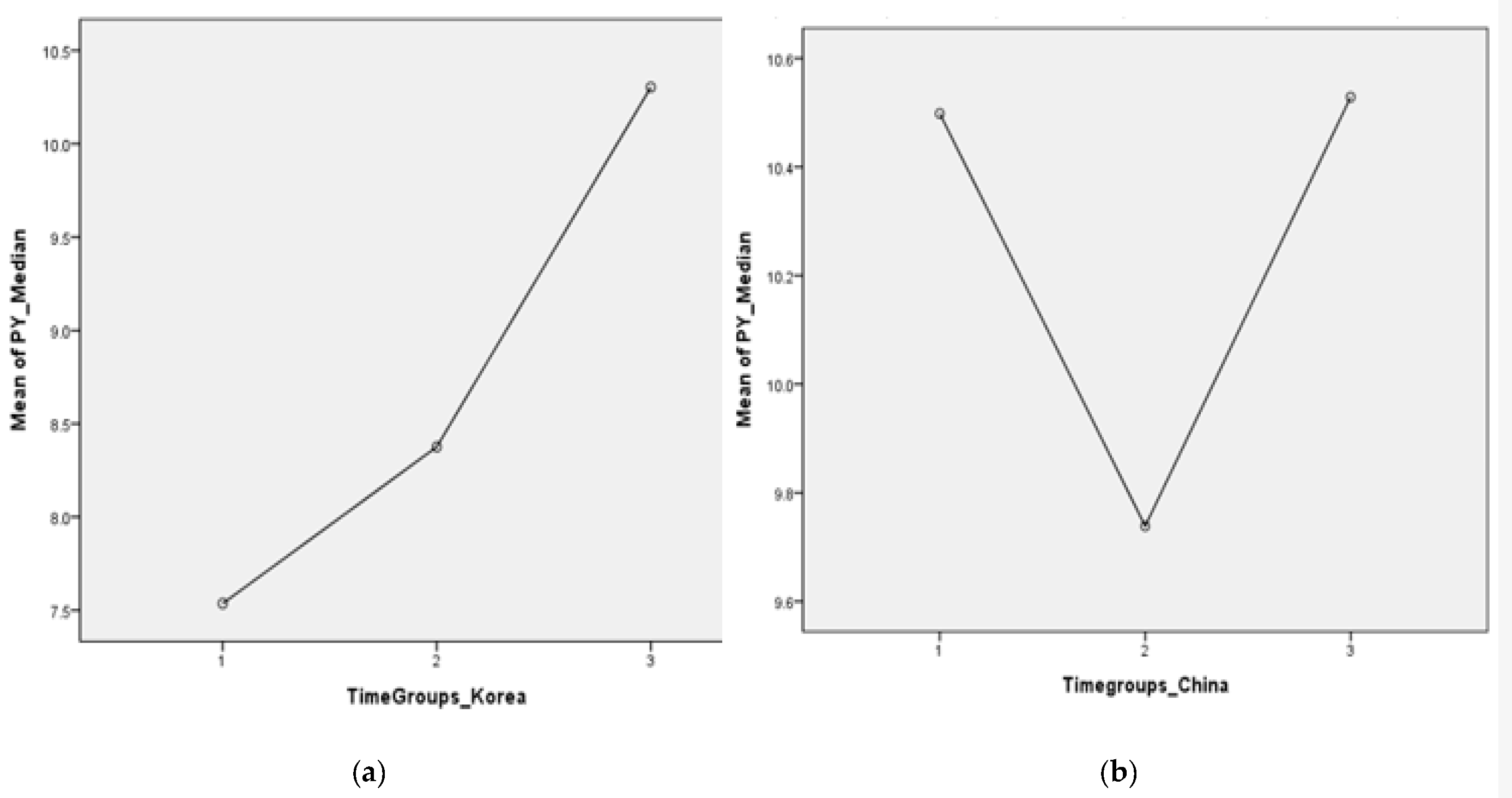
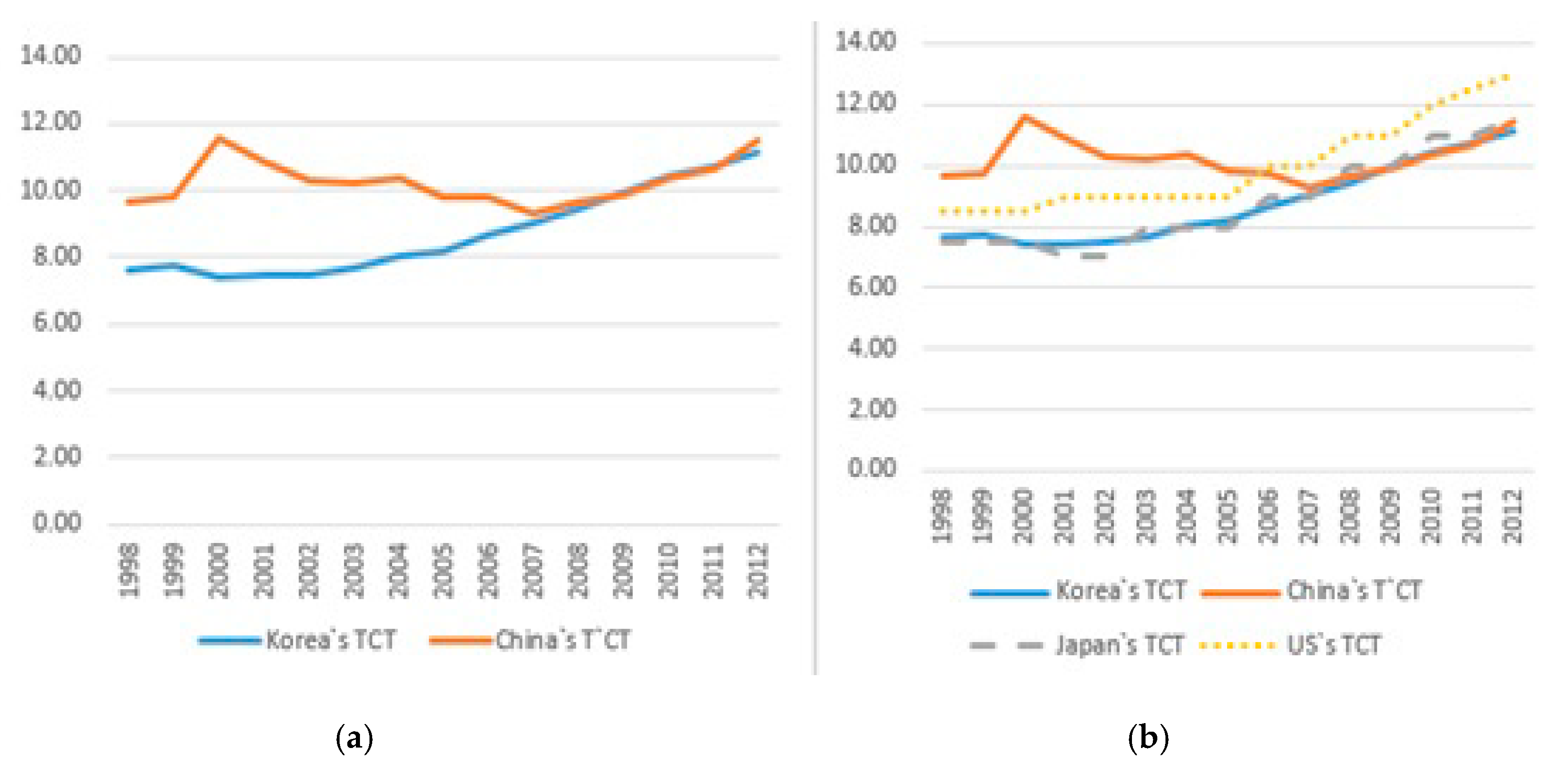
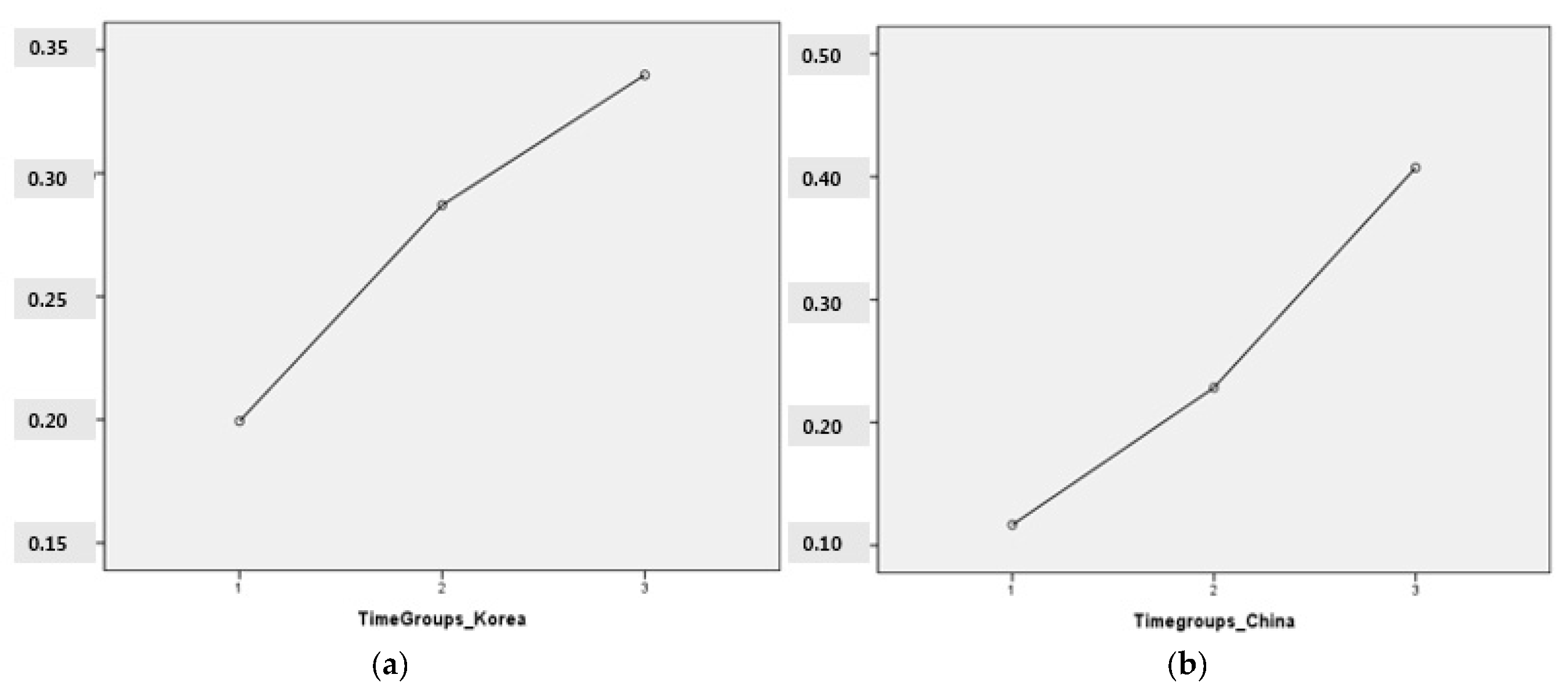
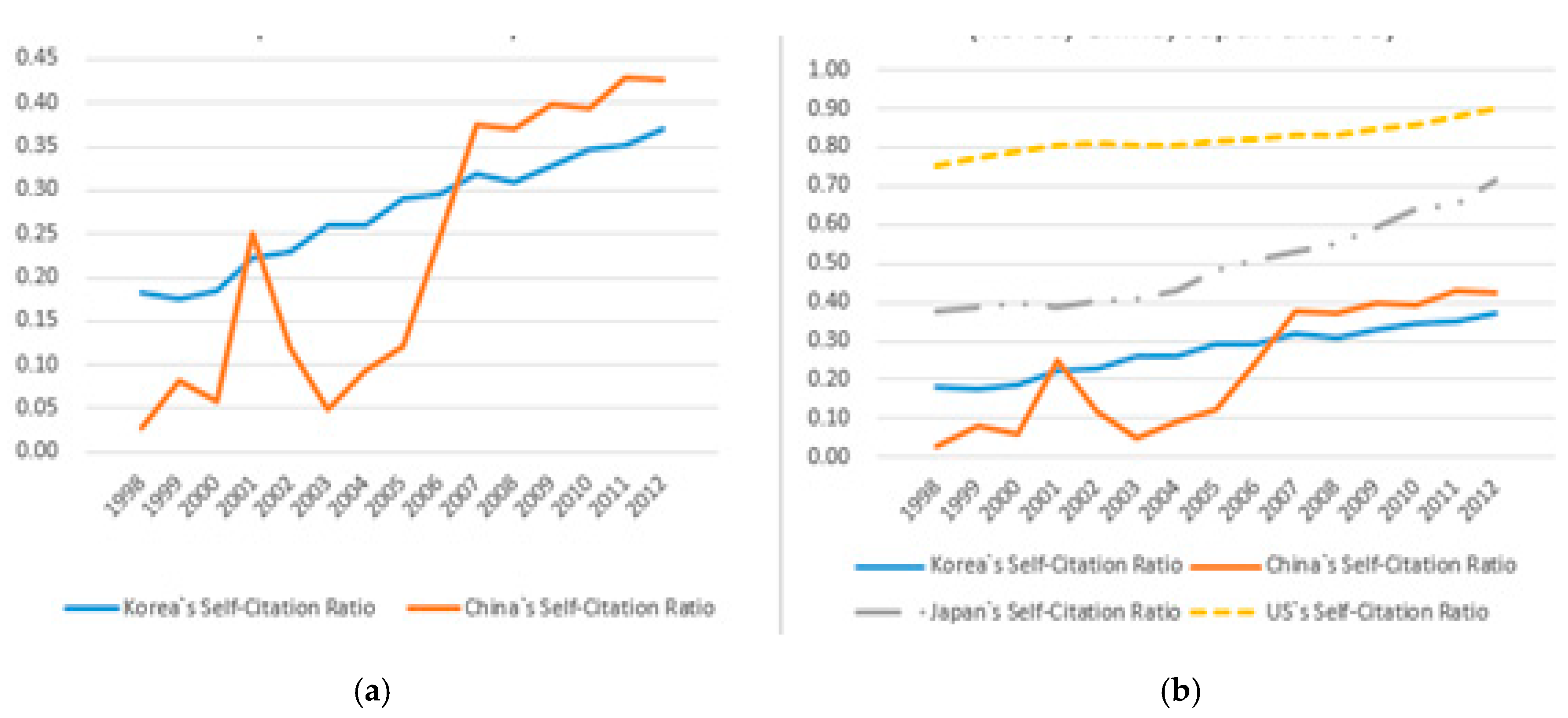
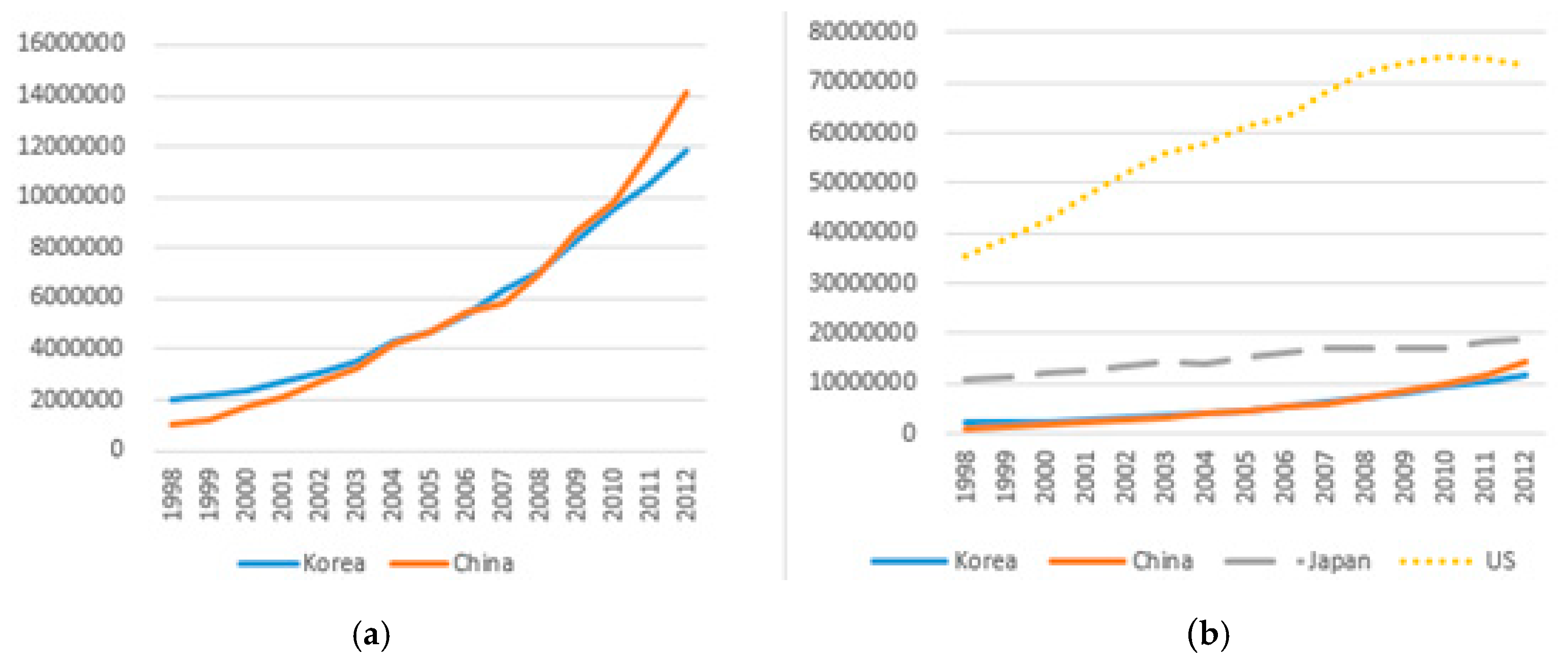
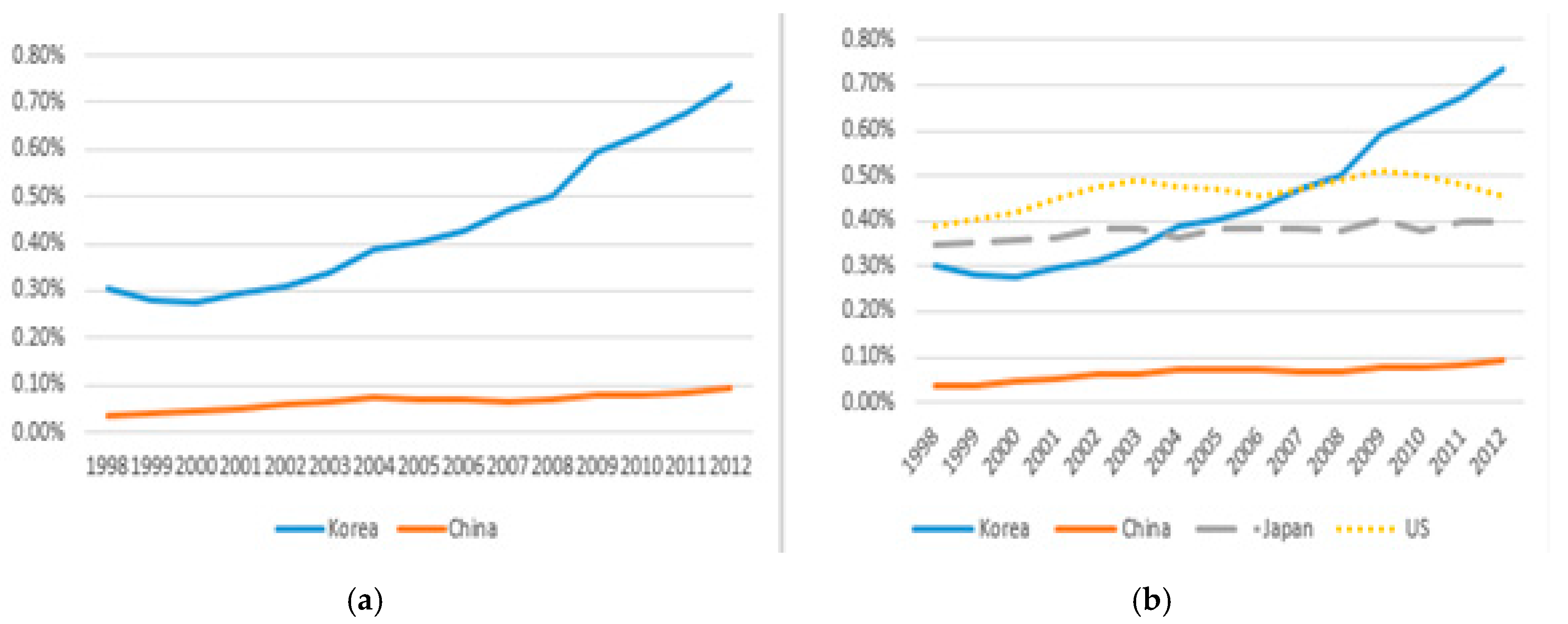
| Stage 1 | Stage 2 | Stage 3 | |
|---|---|---|---|
| Utterback and Abernathy [26] | Fluid | Transition | Specific |
| Bolton [27] | Imitation | Reflective imitation | Innovation |
| Kim [28] | Duplicative imitation | Creative imitation | Innovation |
| Lee [24,25], Lee and Lim [30] | Path-following | Path-skipping | Path-creating |
| Developed countries |
| Dimensions | Argument | Sources | ||
|---|---|---|---|---|
| Catch-Up Period | Post Catch-Up Period | |||
| Technological Regime Changes | Technology Life Cycle | Short Cycle Cector Emblematic Industry: ICT and Electronics | Long Cycle Sector Emblematic Industry: Bio and Medicine | [1,24,25,35] |
| Localization of Knowledge Creation | Low | High | [1,24,25,35,36] | |
| Basic Research Expenditure | Low | High | [1,24,25,35,36] | |
| Organizational & Cultural Change in firms & Social Problems | Imbalanced Growth Inequality Bureaucracy Top-Down Structure Vertical Decision Making Culture | Balanced Growth Toward Equality Democratic and Bottom-Up Structure Horizontal Decision Making Culture | [36,37,38] | |
| South Korea’s TCT Descriptive Statistics | China’s TCT Descriptive Statistics | ||||||
|---|---|---|---|---|---|---|---|
| Groups | 1998–2002 | 2003–2007 | 2008–2012 | Groups | 1998–2002 | 2003–2007 | 2008–2012 |
| Mean | 7.54 | 8.38 | 10.30 | Mean | 10.50 | 9.74 | 10.53 |
| N | 14942 | 18678 | 24118 | N | 309 | 1125 | 4563 |
| SD | 3.753 | 3.654 | 3.997 | SD | 4.943 | 4.813 | 4.778 |
| Var | 14.084 | 13.349 | 15.977 | Var | 24.433 | 23.165 | 22.826 |
| Median | 6.50 | 8.00 | 10.00 | Median | 10.00 | 9.00 | 10.00 |
| Min | 1 | 1 | 2 | Min | 2 | 2 | 2 |
| Max | 29 | 33 | 38 | Max | 28 | 32 | 37 |
| ANOVA Results for South Korea’s TCT | ANOVA Results for China’s TCT | ||||||||||
|---|---|---|---|---|---|---|---|---|---|---|---|
| Sum of Squares | df | Mean Square | F | Sig. | Sum of Squares | df | Mean Square | F | Sig. | ||
| Between Groups | 80,156.494 | 2 | 40,078.247 | 2738.130 | 0.000 | Between Groups | 567.804 | 2 | 283.902 | 12.359 | 0.000 |
| Within Groups | 845,072.092 | 57,735 | 14.637 | Within Groups | 137,693.43 | 5994 | 22.972 | ||||
| Total | 9,525,228.58 | 57,737 | Total | 13,861.239 | 5996 | ||||||
| Paired Samples Test | |||||||||
|---|---|---|---|---|---|---|---|---|---|
| Paired Differences | t | df | Sig. (2-Tailed) | ||||||
| Mean | Std. Deviation | Std. Error Mean | 95% Confidence Interval of the Difference | ||||||
| Lower | Upper | ||||||||
| Pair 1 | KR-CN | −1.513 | 1.396 | 0.360 | −2.285 | −0.740 | −4.198 | 14 | 0.001 |
| Pair 2 | KR-JP | −0.069 | 0.333 | 0.086 | −0.254 | 0.115 | −0.807 | 14 | 0.433 |
| Pair 3 | KR-US | −1.269 | 0.358 | 0.092 | −1.468 | −1.071 | −13.733 | 14 | 0.000 |
| Pair 4 | CN-JP | 1.443 | 1.611 | 0.416 | 0.551 | 2.335 | 3.471 | 14 | 0.004 |
| Korea’s Self-Citation Descriptive Statistics | China’s Self-Citation Descriptive Statistics | ||||||
|---|---|---|---|---|---|---|---|
| Groups | 1998–2002 | 2003–2007 | 2008–2012 | Groups | 1998–2002 | 2003–2007 | 2008–2012 |
| Mean | 0.199 | 0.287 | 0.340 | Mean | 0.117 | 0.228 | 0.407 |
| N | 14942 | 18678 | 24118 | N | 309 | 1125 | 4563 |
| SD | 0.364 | 0.371 | 0.418 | SD | 0.474 | 0.421 | 0.437 |
| Var | 0.133 | 0.138 | 0.174 | Var | 0.224 | 0.177 | 0.191 |
| Median | 0.064 | 0.111 | 0.000 | Median | 0.000 | 0.000 | 0.250 |
| Min | 0.000 | 0.000 | 0.000 | Min | 0.000 | 0.000 | 0.000 |
| Max | 10.263 | 9.333 | 4.900 | Max | 7.643 | 8.000 | 1.000 |
| ANOVA Results for South Korea’s TCT | ANOVA Results for China’s TCT | ||||||||||
|---|---|---|---|---|---|---|---|---|---|---|---|
| Sum of Squares | df | Mean Square | F | Sig. | Sum of Squares | df | Mean Square | F | Sig. | ||
| Between Groups | 181.808 | 2 | 90.904 | 599.095 | 0.000 | Between Groups | 47.991 | 2 | 23.995 | 126.364 | 0.000 |
| Within Groups | 8760.456 | 57,735 | 0.152 | Within Groups | 1138.21 | 5994 | 0.190 | ||||
| Total | 8942.264 | 57,737 | Total | 1186.20 | 5996 | ||||||
| Paired Samples Test | |||||||||
|---|---|---|---|---|---|---|---|---|---|
| Paired Differences | t | df | Sig. (2-Tailed) | ||||||
| Mean | Std. Deviation | Std. Error Mean | 95% Confidence Interval of the Difference | ||||||
| Lower | Upper | ||||||||
| Pair 1 | Korea-China | 0.04467 | 0.10562 | 0.02727 | −0.01382 | 0.10316 | 1.638 | 14 | 0.124 |
| Pair 2 | Korea-Japan | −0.22333 | 0.05434 | 0.01403 | −0.25342 | −0.19324 | −15.919 | 14 | 0.000 |
| Pair 3 | Korea-US | −0.54733 | 0.03390 | 0.00875 | −0.56611 | −0.52856 | −62.523 | 14 | 0.000 |
| Pair 4 | China-Japan | −0.26800 | 0.07692 | 0.01986 | −0.31060 | −0.22540 | −13.493 | 14 | 0.000 |
| ANOVA Results for South Korea’s TCT | ANOVA Results for China’s TCT | ||||||||||
|---|---|---|---|---|---|---|---|---|---|---|---|
| Sum of Squares | df | Mean Square | F | Sig. | Sum of Squares | df | Mean Square | F | Sig. | ||
| Between Groups | 4.505 | 2 | 2.252 | 55.440 | 0.000 | Between Groups | 8.067 | 2 | 4.033 | 43.225 | 0.000 |
| Within Groups | 0.488 | 12 | 0.041 | Within Groups | 1.120 | 12 | 0.093 | ||||
| Total | 4.992 | 14 | Total | 9.186 | 14 | ||||||
| ANOVA Results for South Korea’s TCT | ANOVA Results for China’s TCT | ||||||||||
|---|---|---|---|---|---|---|---|---|---|---|---|
| Sum of Squares | df | Mean Square | F | Sig. | Sum of Squares | df | Mean Square | F | Sig. | ||
| Between Groups | 0.291 | 2 | 0.145 | 41.780 | 0.000 | Between Groups | 0.003 | 2 | 0.002 | 22.952 | 0.000 |
| Within Groups | 0.042 | 12 | 0.003 | Within Groups | 0.001 | 12 | 0.000 | ||||
| Total | 0.333 | 14 | Total | 0.004 | 14 | ||||||
| Paired Samples Test | |||||||||
|---|---|---|---|---|---|---|---|---|---|
| Paired Differences | t | df | Sig. (2-Tailed) | ||||||
| Mean | Std. Deviation | Std. Error Mean | 95% Confidence Interval of the Difference | ||||||
| Lower | Upper | ||||||||
| Pair 1 | Korea-China | 0.378 | 0.140 | 0.036 | 0.300 | 0.455 | 10.463 | 14 | 0.000 |
| Pair 2 | Korea-Japan | 0.065 | 0.141 | 0.036 | −0.013 | 0.143 | 1.790 | 14 | 0.095 |
| Pair 3 | Korea-US | −0.020 | 0.138 | 0.036 | −0.096 | 0.057 | −0.549 | 14 | 0.592 |
| Pair 4 | China-Japan | −0.312 | 0.009 | 0.002 | −0.317 | −0.308 | −142.171 | 14 | 0.000 |
| Pair 5 | China-US | −0.397 | 0.025 | 0.006 | −0.411 | −0.383 | −62.078 | 14 | 0.000 |
| Dimensions | Argument and Discourse | Empirical Finding of the Research | |||
|---|---|---|---|---|---|
| Catch-Up Period | Post Catch-Up Period | Catch-Up Period | Post Catch-Up Period | ||
| Technological Regime Changes | Technology’s Economic Life | Short Cycle Sector Emblematic Industry: ICT & Electronics | Long Cycle Sector Emblematic Industry: Bio & Medicine | Short Cycle Period ICT & Electronics Industry Driven | Long Cycle Period ICT & Electronics Industry Driven Still (TCT got longer) |
| Localization of Knowledge Creation | Low | High | Low | High | |
| Basic Research Expenditure & GDEB % | Low | High | Low | High | |
© 2020 by the authors. Licensee MDPI, Basel, Switzerland. This article is an open access article distributed under the terms and conditions of the Creative Commons Attribution (CC BY) license (http://creativecommons.org/licenses/by/4.0/).
Share and Cite
Choi, S.; Lee, J.; Park, H.-W. A Comparative Study of Sustainable Transition from Catch-up to Post Catch-up of South Korea and China. Sustainability 2020, 12, 4751. https://doi.org/10.3390/su12114751
Choi S, Lee J, Park H-W. A Comparative Study of Sustainable Transition from Catch-up to Post Catch-up of South Korea and China. Sustainability. 2020; 12(11):4751. https://doi.org/10.3390/su12114751
Chicago/Turabian StyleChoi, San, Jongtaik Lee, and Hyun-Woo Park. 2020. "A Comparative Study of Sustainable Transition from Catch-up to Post Catch-up of South Korea and China" Sustainability 12, no. 11: 4751. https://doi.org/10.3390/su12114751
APA StyleChoi, S., Lee, J., & Park, H.-W. (2020). A Comparative Study of Sustainable Transition from Catch-up to Post Catch-up of South Korea and China. Sustainability, 12(11), 4751. https://doi.org/10.3390/su12114751




